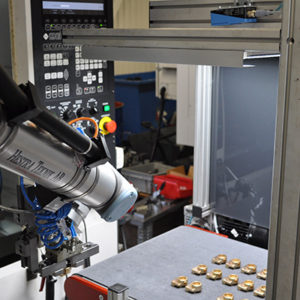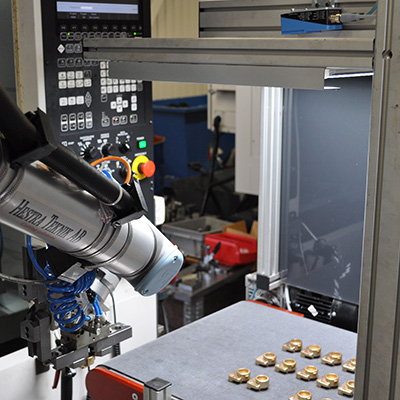The interaction between humans and robots in the factory is growing steadily. Initially, many companies used traditional, industrial robots, but they often came with big investments and are programmed to do same thing over-and-over again for a very long time. With a need for a more flexible, lightweight, and user-friendly robotics solution, collaborative robots aka “cobots” were created. Cobots provide a more versatile solution for companies looking for an easy way to deploy and re-deploy a cobot, without the need for programming experience. And, with vision technology from SICK, you can ensure that your cobots operate at peak efficiency.
The world’s first cobot was launched in 2008 by the Danish company Universal Robots (UR). Today, vision technology enables the cobots to perform a new variety of tasks. Cobots are used in a number of applications, including packaging & palletizing, machine tending, pick & place, assembly, and quality inspection.
Cobots lowering the barrier for automation
 In combination with a low initial investment and a very short payback time, cobots enable companies to take steps toward Industry 4.0. One example of this is the Swedish company, Hestra Teknik, a manufacturing cutting solutions provider. The company uses cobots for part feeding to a CNC machine, eliminating the need for a machine operator. For exact robot guidance, Hestra Teknik uses SICK's Inspector PIM60 2D camera. It handles the localization of the parts on a conveyor belt and the cobot picks the parts and feeds it to the machine. With the Inspector PIM60, they are able to store up to 32 different part configurations on the vision sensor itself.
In combination with a low initial investment and a very short payback time, cobots enable companies to take steps toward Industry 4.0. One example of this is the Swedish company, Hestra Teknik, a manufacturing cutting solutions provider. The company uses cobots for part feeding to a CNC machine, eliminating the need for a machine operator. For exact robot guidance, Hestra Teknik uses SICK's Inspector PIM60 2D camera. It handles the localization of the parts on a conveyor belt and the cobot picks the parts and feeds it to the machine. With the Inspector PIM60, they are able to store up to 32 different part configurations on the vision sensor itself.
Enabling more applications with vision
When adding “eyes” to the robot, there are a lot more things you can do. As a pilot customer, Hestra Teknik integrated the SICK Inspector URCap software, a UR+ plugin, into the robot controller. With this software, it is easy to add the full functionality of the Inspector PIM60 to the robot application: The Inspector PIM60 is an embedded vision sensor, which means that all calculations are done on the sensor itself, and there is no need for an external computer.
The natural step to take with a vision sensor and a robot is to enable robot guidance applications. After the quick calibration routine, the URCap software can output pick-points in the robot’s coordinate system. In addition to outputting coordinates, the Inspector PIM60 enables inspection and measurement tasks for pass/fail-criteria or trending.
The SICK Inspector URCap software offers an easy-to-use interface for the Inspector PIM60 and robot integration. There is no need for setting up an additional PLC or other communication system. This solution offers an accessible way to reduce monotonous work for the operator and allows the user to expand the use of collaborative robots.





